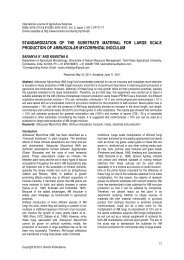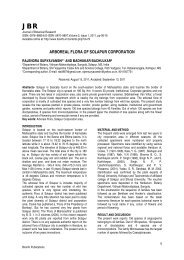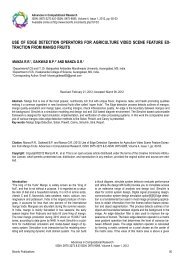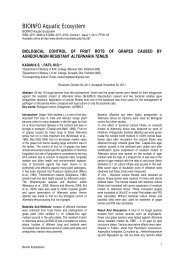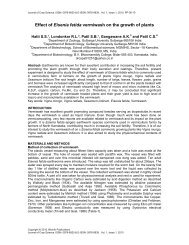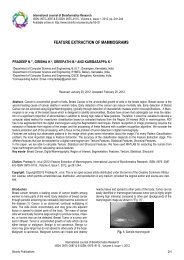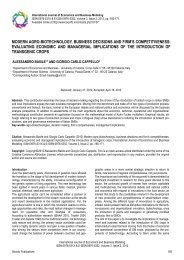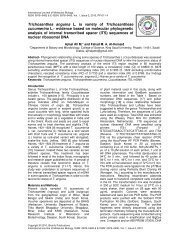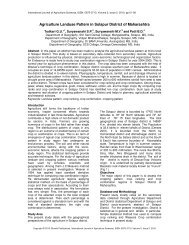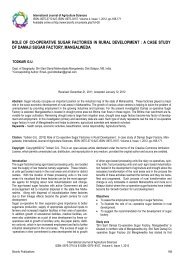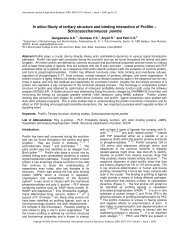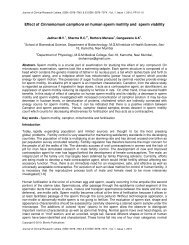Role of bioinformatics in agriculture and sustainable development
Role of bioinformatics in agriculture and sustainable development
Role of bioinformatics in agriculture and sustainable development
Create successful ePaper yourself
Turn your PDF publications into a flip-book with our unique Google optimized e-Paper software.
elieved [3, 4, 5, 6]. These f<strong>in</strong>d<strong>in</strong>gs suggest that<br />
<strong>in</strong>formation obta<strong>in</strong>ed from the model crop systems can<br />
be used to suggest improvements to other food crops.<br />
Arabidopsis thaliana (water cress) Oryza sativa (rice),<br />
Triticum aestivum (wheat) <strong>and</strong> Zea mays (Maize) are<br />
examples <strong>of</strong> available complete l<strong>and</strong> plant genomes [7,<br />
8].<br />
What can genome sequence tell us?<br />
Some organisms have multiple copies <strong>of</strong> chromosomes,<br />
diploid, triploid, tetraploid <strong>and</strong> so on. In classical<br />
genetics, <strong>in</strong> a sexually reproduc<strong>in</strong>g organism (typically<br />
eukaryotes) the gamete has half <strong>of</strong> the number <strong>of</strong><br />
chromosome <strong>of</strong> the somatic cell <strong>and</strong> the genome is a full<br />
set <strong>of</strong> chromosomes <strong>in</strong> a gamete. The term genome can<br />
be applied specifically to mean that stored on a complete<br />
set <strong>of</strong> nuclear DNA (i.e., nuclear genome) but can also<br />
be applied to that stored with<strong>in</strong> organelles that conta<strong>in</strong><br />
their own DNA, as with the ‘mitochondrial genome’ or the<br />
‘chloroplast genome’. Additionally, the genome can<br />
comprise non chromosomal genetic elements such as<br />
viruses, plasmids, <strong>and</strong> transposable elements.<br />
Most biological entities that are more complex than a<br />
virus, sometimes or always, carry additional genetic<br />
material besides that which resides <strong>in</strong> their<br />
chromosomes. In such circumstances ‘genome’<br />
describes all <strong>of</strong> the genes <strong>and</strong> <strong>in</strong>formation on non-cod<strong>in</strong>g<br />
DNA that have the potential to be present. In eukaryotes<br />
such as plants, protozoa <strong>and</strong> animals, however,<br />
‘genome’ carries the typical connotation <strong>of</strong> only<br />
<strong>in</strong>formation on chromosomal DNA [9]. The genetic<br />
<strong>in</strong>formation conta<strong>in</strong>ed by DNA with<strong>in</strong> organelles i.e.,<br />
chloroplast <strong>and</strong>/or mitochondria is not considered part <strong>of</strong><br />
the genome. In fact, mitochondria are sometimes said to<br />
have their own genome <strong>of</strong>ten referred to as the<br />
‘mitochondrial genome’. The DNA found with<strong>in</strong> the<br />
chloroplast may be referred to as the ‘plastome’.<br />
Comparative analysis with<strong>in</strong> microbial genome us<strong>in</strong>g<br />
metabolic comparison <strong>and</strong> gene organization at<br />
metabolic reactions level with their operons us<strong>in</strong>g<br />
structure, pathway, reaction, compounds <strong>and</strong> gene<br />
orthologs gives better underst<strong>and</strong><strong>in</strong>g <strong>of</strong> genome<br />
evolution [10, 11]. Variation <strong>in</strong> the genome size, GC<br />
content, codon usage <strong>and</strong> am<strong>in</strong>o acid composition based<br />
on sta<strong>in</strong>s <strong>of</strong> the same species, closely related species<br />
<strong>and</strong> distantly related species. Col<strong>in</strong>earity between gene<br />
set show<strong>in</strong>g their evolutionary differences <strong>in</strong> evolution <strong>of</strong><br />
<strong>in</strong>dividual genes.<br />
Improve nutritional quality <strong>and</strong> growth <strong>in</strong> poorer<br />
soils<br />
Gene-Diet-Disease <strong>in</strong>teraction <strong>of</strong> Nutritional genomics<br />
aims to study the susceptible genes <strong>and</strong> provide dietary<br />
<strong>in</strong>terventions for <strong>in</strong>dividuals at risk <strong>of</strong> such diseases.<br />
Scientists have recently succeeded <strong>in</strong> transferr<strong>in</strong>g genes<br />
<strong>in</strong>to rice to <strong>in</strong>crease levels <strong>of</strong> Vitam<strong>in</strong> A, iron <strong>and</strong> other<br />
micronutrients. This work could have a pr<strong>of</strong>ound impact<br />
<strong>in</strong> reduc<strong>in</strong>g occurrences <strong>of</strong> bl<strong>in</strong>dness <strong>and</strong> anaemia<br />
caused by deficiencies <strong>in</strong> Vitam<strong>in</strong> A <strong>and</strong> iron<br />
respectively. Scientists have <strong>in</strong>serted a gene from yeast<br />
<strong>Role</strong> <strong>of</strong> <strong>bio<strong>in</strong>formatics</strong> <strong>in</strong> <strong>agriculture</strong> <strong>and</strong> susta<strong>in</strong>able <strong>development</strong><br />
International Journal <strong>of</strong> Bio<strong>in</strong>formatics Research<br />
ISSN: 0975–3087, E-ISSN: 0975–9115, Vol. 3, Issue 2, 2011<br />
<strong>in</strong>to the tomato, <strong>and</strong> the result is a plant whose fruit stays<br />
longer on the v<strong>in</strong>e <strong>and</strong> has an extended shelf life.<br />
Bio<strong>in</strong>formatics play an important role to detect the metal<br />
from Metagenomic sequenc<strong>in</strong>g obta<strong>in</strong>s from<br />
contam<strong>in</strong>ated soil [12]. Soil arguably houses the most<br />
complex microbial communities because <strong>of</strong> its ancient<br />
history, complex sets <strong>of</strong> <strong>in</strong>terrelat<strong>in</strong>g gradients, <strong>and</strong><br />
protective, isolat<strong>in</strong>g <strong>and</strong> relatively resource poor <strong>and</strong><br />
stable physical structure. This results <strong>in</strong> an <strong>in</strong>credibly<br />
diverse set <strong>of</strong> gene sequences; at least at the scale soils<br />
are normally sampled. The challenge is no longer<br />
sequence yield, but the analysis <strong>of</strong> those sequences,<br />
<strong>and</strong> especially so due to the short sequence products <strong>of</strong><br />
current sequenc<strong>in</strong>g technologies. Progress has been<br />
made <strong>in</strong> develop<strong>in</strong>g cereal varieties that have a greater<br />
tolerance for soil alkal<strong>in</strong>ity, free alum<strong>in</strong>um <strong>and</strong> iron<br />
toxicities.<br />
Improvement for plant resistance aga<strong>in</strong>st biotic <strong>and</strong><br />
abiotic stresses<br />
Application <strong>of</strong> <strong>in</strong>sect genomics helps <strong>in</strong> the identification<br />
<strong>of</strong> resistance mechanisms <strong>and</strong> f<strong>in</strong>d<strong>in</strong>g the novel target<br />
sites [13]. Genes from Bacillus thur<strong>in</strong>giensis that can<br />
control a number <strong>of</strong> serious pests have been<br />
successfully transferred to cotton, maize <strong>and</strong> potato. This<br />
new ability <strong>of</strong> the plants to resist <strong>in</strong>sect attack means that<br />
the amount <strong>of</strong> <strong>in</strong>secticides be<strong>in</strong>g used can be reduced.<br />
A plant’s first l<strong>in</strong>e <strong>of</strong> defense aga<strong>in</strong>st abiotic stress is <strong>in</strong><br />
its roots. If the soil hold<strong>in</strong>g the plant is healthy <strong>and</strong><br />
biologically diverse, the plant will have a higher chance<br />
<strong>of</strong> surviv<strong>in</strong>g stressful conditions. Plants are extremely<br />
sensitive to the changes, <strong>and</strong> do not generally adapt<br />
quickly. Plants also adapt very differently from one<br />
another, even from a plant liv<strong>in</strong>g <strong>in</strong> the same area. When<br />
a group <strong>of</strong> different plant species was prompted by a<br />
variety <strong>of</strong> different stress signals, such as drought or<br />
cold, each plant responded uniquely. Hardly any <strong>of</strong> the<br />
responses were similar, even though the plants had<br />
become accustomed to exactly the same home<br />
environment. So, species are more likely to become<br />
population threatened, endangered, <strong>and</strong> even ext<strong>in</strong>ct,<br />
when <strong>and</strong> where abiotic stress is especially harsh. By<br />
us<strong>in</strong>g <strong>in</strong> silico genomics technology researcher can<br />
identify defense/ disease resistance gene-enzyme with<br />
their promoter region <strong>and</strong> transcription factor which help<br />
to enhance the immunity <strong>and</strong> defence mechanism [14,<br />
15].<br />
Similarity Search<strong>in</strong>g Tools<br />
The exponential growth <strong>of</strong> genomics is due to<br />
computational challenges <strong>of</strong> systematically collect<strong>in</strong>g,<br />
stor<strong>in</strong>g, organiz<strong>in</strong>g, manipulat<strong>in</strong>g visualiz<strong>in</strong>g <strong>and</strong><br />
analyz<strong>in</strong>g large amounts <strong>of</strong> biological <strong>in</strong>formation come<br />
from the experiments carried out by the biologists.. Thus,<br />
<strong>bio<strong>in</strong>formatics</strong>, <strong>in</strong> its broad sense, can be seen as<br />
provid<strong>in</strong>g both the <strong>in</strong>frastructure <strong>and</strong> the scientific<br />
framework <strong>in</strong> which biologists take <strong>in</strong>formation <strong>and</strong> use<br />
computers to help convert it <strong>in</strong>to knowledge [16]. Apart<br />
from the fact that <strong>bio<strong>in</strong>formatics</strong> is a newly recognized<br />
discipl<strong>in</strong>e; there is an impressive diversity <strong>of</strong><br />
222



